Making movies. Enjoying movies. Remembering movies.
THE BACKLOT
|
|
|
|
|
Posted September 27, 2004 |
|
The Wizard Of Sunset A Story About One Man's Desire To Make The Cinema Experience Better |
By
William Kallay
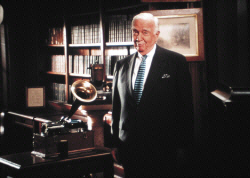 |
In the Harmony Gold Theatre in Hollywood, right off the bustling Sunset Strip, a magical movie demonstration is being shown to an audience. A collection of audience members utter words like “wow,” and “ooh,” only with silent exclamation points at the end of their delighted sentences. Some audience members even ask the inventor, Robert C. Weisgerber, and the producer of the film, Barrie O’Brien, if they can see it again.
Eye candy never looked so good.
The footage and projection system, called Super Dimension-70ä, developed by Weisgerber, is perhaps one of the most revolutionary inventions in the film business in years. And that’s causing some in the movie industry to take notice.
In an era of teen flicks and cookie-cutter cineplexes, Weisgerber has re-invented the movie reel. At the same time, he’s brought back a sense of magic long gone from the movies today; that the experience of how audiences see a movie can be just as important as the movie itself.
The demonstration begins with a subtle, simple introduction with the comfortable presence of Walter Cronkite. He talks about the earliest days of moviemaking by the Father of Invention, Thomas Edison. The image fills the middle part of a large, widescreen. After Cronkite’s short introduction, the screen masking widens and the audience is literally thrust into the picture frame. Footage of a horse and handsome cab riding through Central Park pops off the screen, causing audience members to reach out and try to touch the animal. They’ve been fooled by an optical illusion. Super Dimension-70 isn’t 3-D, only better. There are no clunky goggles or cheap plastic glasses to wear. A boat ride through New York Harbor takes on the sense of an amusement park ride-simulator, causing the audience to grab onto their arm rests. Watching this scene, one might think of how a film like a "Matrix" sequel or "Star Wars" sequel might look in this high-impact modus operandi. To be forward, it’s simply incredible and jaw dropping. And in an intimate tableside scene with a young couple, the footage looks like it would be in place in a Julia Roberts movie. Super Dimension-70 handles these types of scenes with aplomb. It hasn’t been uncommon for audience members to ask, “Why can’t all movies be shown this way?”
Back In Time
Inspired by the general decline in how movies are shown in theatres today, New York natives Weisgerber and O’Brien took a look at the last time when movies were high-definition and high-class: the 1950s and 1960s. These were times where technology and PT Barnum hucksterism went hand-in-hand. The two forces combined to combat a mortal enemy known as television.
The era began out of desperation, really. Television cut into movie attendance severely by the early 1950s. There was a scramble by producers and studios to find a gimmick to lure people back into the theatre and earn back lost box office revenue. This meant making flat, two-dimensional film into immersing 3-D.
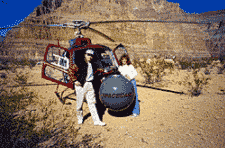 |
|
Robert Weisgerber & Barrie O'Brien |
It meant making the almost square movie theatre screens of the day wider and bigger. It meant super-sizing the industry standard, 35mm film, by optically stretching it in more ways than one, or simply, making it bigger.
The 3-D craze lasted for a short time, but it was Cinerama that redefined cinema forever. The wide, three-projector, 146-degree, three-paneled screen, offered audiences an immersing trip on a roller coaster ride, a flight over the Grand Canyon and a chance to water ski, all within the confines of a theatre auditorium. The film, "This Is Cinerama" (1952), was a sensation around the globe. More or less, the film was nothing more than a simple combination of pretty scenery and lush orchestral music: a travelogue. But the impact was enormous on audiences and film industry of the day. So successful was Cinerama, it spawned imitators, in various forms, including CinemaScope (1953), VistaVision (1954), Todd-AO (1955) and Super Panavision 70 (1959), to name a few. The gimmicks worked. The box office was flush with revenue again.
Producers like Mike Todd and Samuel L. Bronston elevated movies, for a brief time, to Broadway sophistication. The combination of a strong literary property, or a major musical, married with the gimmicks of the day, lent themselves to the era of “roadshow” movies. Going to the movies was something to cherish. "Oklahoma!" (1955), "South Pacific" (1958), "Ben-Hur" (1959) "Spartacus" (1960), "El Cid" (1961), "West Side Story" (1961), and "Lawrence Of Arabia" (1962), provided audiences with a theatrical movie experience, something beyond seeing a matinee at the local Bijou.
People bought reserved seat tickets, got dressed up and went to the major movie palaces downtown. Once inside, they were given a program about the film. Walking into the auditorium, they saw lush curtains covering the screen. Ushers escorted them to their seats. The floors were of the non-stick type. The theatre showing a particular movie held itself to high standards of presentation. The sense of selling presentation was just as important as selling popcorn. And just like in a Broadway musical, there was often an overture before the film began flickering on the screen. The overture ended, the lights faded away and the curtains opened to reveal a large, wide screen. The movie began and the audience was swept away. These were truly movies to be seen on the big screen.
Many films of this caliber were shot and shown in the 70mm format, a format Weisgerber has revisited for Super Dimension-70. Twice the size of industry standard 35mm film, the larger format allowed for a superior cinematic presentation. A brighter, sharper, steady and defined picture, combined with dynamic multichannel stereo surround sound, gave audiences the best possible visual and sound presentation available.
“It was an overall enveloping experience of both audio and picture, with a virtually grainfree, velvet-like image, and a bright evenly lit screen,” says Robert A. Harris, film preservationist, who has helped save large format films like "Lawrence Of Arabia" and "Spartacus" from fading away from our film history. He’s in the process of raising funds, with help from MGM, to save John Wayne’s 70mm epic, "The Alamo" (1960). He adds, “70mm is an extraordinary experience.”
Movies weren’t merely movies; they were an event. The bar of cinema presentation was at a peak and hasn’t really been seen since.
The era of quality film presentation virtually ceased by the end of the 1960s. Audiences preferred low budget, counter-culture films like "Easy Rider," as opposed to big budget Hollywood fare like "Hello, Dolly!" Numerous movie palaces closed down or were converted into “twin” theatres. And the rise of the multi-screen theatre transformed the movie-going experience into a matter of convenience, rather than showmanship.
Seeking To Make The Movie Experience Better
These days, the way audiences see the latest blockbusters in local theatres is usually a far cry from the era of the roadshow. In fact, it’s a far cry from what modern directors and cinematographers intended for them to see. The careful choices of lighting, composition, color, etc., are often tossed aside once a print of a film arrives at the theatre.
“Exhibition is a major part of our work,” says Laszlo Kovacs, ASC, cinematographer on numerous films, including "Easy Rider" and "Miss Congeniality." “By the time a film I’ve worked on gets to the theatre, it gets destroyed.”
In a world where consumers demand high quality DVDs, digital music and the fastest computers, it’s ironic that many consumers don’t complain about the general quality of how they see movies at the theatre.
The recent influx of stadium seating theatres, with their huge 80-foot screens, perks of the modern movie theatre, have certainly added new amenities to the movie-going experience, but at a cost. The 35mm format, the standard way to show movies around the world, can’t handle the extra load of being pushed beyond its limits. The film image is too small to cover a huge 80-foot screen. As a result, audiences have seen visually dim, bloated and lifeless prints of films. Mr. Steven Spielberg might be shocked to see how his films look in most cinemas around the country.
Weisgerber saw the decline of cinematic presentation and decided, with some tinkering in the lab, perhaps he could build a better mode of movie delivery.
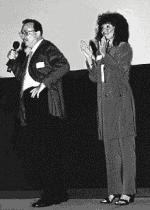 |
|
Robert Weisgerber & Barrie O'Brien |
“As a media person and as a filmgoer, I found that there was a certain lack of entertainment value needed in the filmed marketplace, meaning that content is king,” says Weisgerber, who is the CEO and President of Super Vista Corporation, the company behind Super Dimension-70, a.k.a. SDS-70. He, along with Vice President and producer, Barrie O’Brien, set out to develop a production and theatrical system which substantially improved the way audiences see and experience movies. If digital sound improved how audiences hear movies in the theatre, why shouldn’t the picture be improved, too?
“The important aspect of the process was to raise the bar of cinematography and exhibition so high, that whether my mother or grandmother came to the movie theatre or a big name studio-head came, they would be impressed with what they saw. Not just because it was big, but because it was sharp, clear and dimensional,” says Weisgerber.
Weisgerber figured that the root of the pictorial problem lay in the production and projection systems themselves. Why not go with bigger film, 70mm, and tweak it? Pooling his extensive broadcasting experience and resources together, Weisgerber first built a projector. The first plan on his agenda with this new projector was to eliminate problems normally associated with film: flicker, weaving back and forth and strobing. The projector, called the SDS-70 Impact Projector, projects 70mm film at 48 frames-per-second. Most movies shown in theatres around the world are shot and shown on 35mm film, at 24 frames-per second. The increased size of 70mm film, matched with an increased frame rate, unveils a rock-steady image that is bright and without flicker and nearly hyper-realistic. The SDS-70 Impact Projector yields a “display rate” of 96 images per second, which has never been done before.
O’Brien put together a demonstration film for the format. She, along with a small crew of experienced filmmakers, went out to various locations around the United States and shot 70mm footage. The result is a demonstration film that has audiences wanting to see more. SDS-70 creates a visual widescreen presentation that is superior to past and present systems like Cinerama, CinemaScope, Todd-AO, and the new kid on the block, digital projection. It even looks superior to the current industry flagship in projection quality, IMAX.
What does this mean to the average moviegoer? It’s been proven that audiences will go out of their way to see movies presented in the latest gimmickry. Audiences flocked, of course, to see movies in Cinerama and CinemaScope. The film "Tommy" (1975) amazed teenagers in the mid-1970s when it was shown in
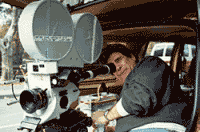 |
|
Cinematographer Mike Huss |
Quintaphonic Sound. Film fans, in which every summer offered a plethora of popcorn movies, sought out theatres which had huge screens with 70mm projection and Lucasfilm THX Sound during the 1980s. In other words, audiences will seek out better quality if it’s available. The same could hold true for Super Dimension-70.
“There’s one exhibitor, president of one of the largest chains, who said, ‘What you just showed me is brighter, sharper and clearer than IMAX. And best of all, the format fits into any of my theatres.’ To me, that was an enormous testimonial. And this was nobody to slouch at,” says Weisgerber.
We Live In A Digital World
But why all the fuss over old-fashioned technology? Isn’t digital cinema, with its bits and bytes, ones and zeroes, the wave of the future? Won’t it give audiences crisp, flicker and scratch-free pictures? And after all, didn’t George Lucas shoot "Star Wars:Episode II - Attack of the Clones," his next "Star Wars" space opera, on new-fangled digital camcorders? Weisgerber and O’Brien have their work cut out for them. Companies like Sony, Panavision, Disney, Texas Instruments, Boeing and Kodak have been jumping into the digital fray over the past two years.
Studios claim that the traditional way of film delivery to thousands of theatres around the country costs them money. They’re correct. On any given major studio release, up to 3,000 35mm prints may be struck, then shipped and distributed to theatres by opening day. The reasoning to go completely digital, from digitally shooting a movie to digitally projecting it at the theatre, is appealing for studios and companies with investments in the technology. It’s a cost savings plan, at least in the long run. Essentially, it would be the studios and manufacturers of digital theatre equipment who would benefit, not the theatre chains.
To convert theatres to digital projection is expensive and literally requires a scientist versed in digital technology to monitor the equipment. And who is going to pay for installing digital cinema in theatres, many of which have filed for Chapter 11? There have been some rumblings that Denver billionaire, Phillip Anchutz, may convert many of his newly purchased theatres to digital technology. But does he want to invest in a technology which changes nearly as often as computer technology?
Another factor to consider with digital projection is an issue of quality. To some in the film industry, it’s just not there, yet. To others, it’s merely an extension of what consumers can get at home: high-definition television. And, for the time being, digital projection is a low-resolution format. Using television as an analogy, and if one were to apply “pixels” to the various modes of movie delivery, current digital projection has about 1.3 to 2 million pixels, a 35mm print has about 4-5 million pixels and Super Dimension-70 has about 22 million pixels. The more pixels on a movie screen, the better the image quality.
A Simple Plan
Weisgerber and O’Brien’s business plan seems to be beneficial to both the studios and exhibitors with Super Dimension-70. Studios could shoot one of their “event” films in Super Dimension-70. The cost to them is slightly more expensive than shooting on 35mm or digital tape, but it’s negligible when budgets run at about $100 million. The benefit for them to shoot in the format is an increase on the value of their film being an “event” film. Certain movies, like the summer blockbusters, deserve to be shown in the best light. It’s worked in the past and could work in the future. Such classics as "Lawrence of Arabia" and "2001: A Space Odyssey" (1968) continue to pack movie theatres long after their original releases. Why? Because they were event films made for the large screen with exceptional storylines. Audiences enjoy spectacle.
Exhibitors would not have to buy a SDS-70 projection system, according to Weisgerber. They would license it from Super Vista Corporation, who would then service each theatre that had the equipment. This would ensure quality presentations at every showing. The system would be limited to being installed in premiere theatre, such as theaters in major metropolitan areas (i.e. Grauman’s Chinese Theater in Hollywood or Loews Lincoln Square in New York City). Also, a select few Hollywood films would be shot in SDS-70, thus making seeing films in the format a special event. Standard 35mm prints, DVDs and digital tape copies can be made from a SDS-70 negative. In other words, the system is multi-compatible from the time a movie is shot in SDS-70, to the time it shows up on DVD.
A theater with the SDS-70 would charge about $3 more for a ticket, earning more money at the box office for the exhibitor, distributor and Super Vista Corporation.
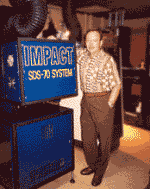 |
|
Weisgerber and the Impact Projector |
“We believe that this is a value-added entertainment. You can charge more, just like 'Fantasia 2000' in IMAX,” says O’Brien. That film went onto earn approximately $65 million in a little over 50 theatres worldwide. That was an incredible gross, considering that an average studio feature is released on 2500-3000 screens on opening day and may not earn that much. Audiences were willing to spend an extra few dollars, because they perceived the film to be an event, something special, and unlike anything they saw in their local megaplex or on DVD.
So imagine, if it were possible, seeing the upcoming "Spider-Man" sequel in Super Dimension-70. The images on the screen are so clear, you duck in your seat as Spider-Man sprays cobwebs on criminals.* Super Dimension-70 would literally make the audience participant in that comic book movie environment. What a thing for film fans to wish upon.
The Movie Industry
In the meantime, some people behind digital cinema and other competing formats have seen the SDS-70 demonstration film. Admittedly, they’ve been highly impressed. Some have sat in their seats long after the demonstration has concluded, mouths agape and eyes wide open--just like everyone else. As for cinematographers, the folks who shoot films, they’ve been chomping at the bit to use the system. And, as much as backers of competing technologies hate to admit it, SDS-70 certainly gives their formats a run for their money. In a way, it’s David versus Goliath, with Weisgerber and O’Brien showing the industry that money can be made with a super film format, at virtually little cost to the studios and exhibitors.
So why hasn’t the film industry embraced this fantastic way to see movies? For a few reasons. Mainly, because some studios have already invested in digital cinema, and to a lessor extent, IMAX/Giant Screen presentations. These are fields in which they can potentially earn revenue. There is also a stigma about shooting a movie in 70mm, which can be traced back to the '60s, where cameras were bulky and making prints was expensive. Many camera systems prior to the roadshows were bulky contraptions, including the much lauded 3-strip Technicolor cameras of the '30s and '40s.
Today, some erroneously claim it’s too cost prohibitive and there aren’t anymore theatres to show the format in, anyway. The cost is negligible, prints are cheaper than before and there are many theatres that can be fitted, quite easily, with a SDS-70 Impact projector. The other factor may well be that Super Dimension-70 is just too good. And that may have the proponents of digital cinema looking over their shoulder.
But do audiences really care about how what format a movie is shown in?
“It’s like automobile companies saying, ‘You know what? It’s got four wheels; it’s got an engine. People just want to get from Point A to Point B. Why do we have to build this very expensive, high performance car?’ But people want the more elaborate cars. They don’t want a commodity item. They want upscale. They want to be able to choose. And that’s what this is all about. Right now, it’s not by chance that the audience is going down. I think that if you improve the experience, I think you’ll tap into age groups that normally don’t go to the movies,” says Weisgerber.
Has anyone seen Mr. Lucas or Mr. Spielberg driving by the Harmony Gold Theatre lately?
Special thanks to Robert C. Weisgerber and Barrie O'Brien
*2004's release of "Spiderman 2" had a large format release in IMAX's Digital Remastering process known as DMR.
This interview was originally posted at www.widescreenreview.com in 2002.
